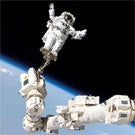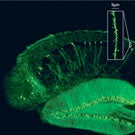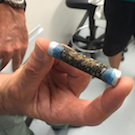Physics Professor Manuel Calderón de la Barca Sánchez and his students are using the largest and most complex machine ever built to probe the strongest force in nature at the tiniest of scales.
“In a nutshell we’re trying to recreate a state of matter that existed about a microsecond after the Big Bang,” he said.
Calderón de la Barca Sánchez and graduate students Graham Waegel, Jared Jay, Ota Kukral and Santona Tuli are among a team of about 100 scientists running “heavy ion” experiments with the Compact Muon Solenoid detector, part of the Large Hadron Collider at CERN, Switzerland. They are trying to create a state of matter called the quark-gluon plasma by smashing nuclei of lead atoms into each other.


Their research, supported by the National Science Foundation, is the focus of a new IMAX movie, “Secrets Of The Universe,” which premiered in July 2019. Calderón de la Barca Sánchez narrates the movie as it takes viewers inside CERN and on a journey through science.
The Ancient Greeks proposed that matter was made up of “indivisible” atoms. Hundreds of years later, scientists showed that atoms were not indivisible at all: electrons could be pulled away from them. In the twentieth century physicists showed that the atomic nucleus could itself be split up into protons and neutrons, and then that these particles could themselves be broken up into fundamental particles called quarks.

Quarks are bound together by the “strong force.” Carried by particles called gluons, it’s the strongest force of nature but operates only at the tiniest of scales.
“What we are trying to do is heat up matter such that we are able to study things that are inside protons and neutrons, so we can see how quarks and gluons acted at the time of creation,” Calderón de la Barca Sánchez said. This melted state is called the quark-gluon plasma.
Melting a proton requires enormously high temperatures – a hundred thousand times that of the core of the sun, but on a tiny scale. That can only be achieved with a couple of colliders in the world: CERN’s Large Hadron Collider, and the Relativistic Heavy Ion Collider at Brookhaven National Laboratory in Upton, New York.
Colliding heavy ions
Most of the time, the Large Hadron Collider smashes streams of protons into each other. That high-energy work led to the discovery of the Higgs boson in 2011 and continuing searches for dark matter particles and evidence of a new theory called supersymmetry. A number of UC Davis physicists are involved in those efforts, alongside thousands of scientists from around the world.
Calderón de la Barca Sánchez’s team has a different approach. Their “heavy ion” experiments accelerate and collide streams of lead nuclei. These collisions cannot reach the same overall energy as proton-proton collisions, but because the nucleus of a lead atom has 82 protons and 126 neutrons, you get a lot more individual collisions when two lead nuclei hit each other.

Those collisions are detected with the Compact Muon Solenoid, a five-story, 14,000 tonne device that is one of four major detectors in the Large Hadron Collider. The CMS is the primary experiment for U.S. researchers working at CERN. Physicists from the UC Davis College of Letters and Science were among the first to sign on to the CMS experiment back in 1992 and have collaborated in designing and building the machine.
The large number of collisions allows the researchers to study the thermodynamics of quark-gluon plasma. Calderón de la Barca Sánchez compared it to studying water freezing or melting.
“If you want to study the transition from solid to liquid water, you would look at a lot of water molecules, not just one molecule,” he said.

The strong force is different from other fundamental forces such as electromagnetism and gravity because it gets stronger with distance and weakens as objects get closer. So scientists had thought that at a very small scale, the quark-gluon plasma should act like a gas. Instead, they found that it’s more like a liquid.
“What we are making is quark soup,” Calderón de la Barca Sánchez said. “We’ve been trying to unravel what this means for the past ten years.”
It’s the most basic of fundamental research, but the work at CERN also brings real-world benefits. Most of the world’s particle accelerators are now in hospitals, where they are used to treat tumors or in medical imaging. CERN scientists created the original software for the World Wide Web as a way to collaborate and organize documents: there are numerous other spinoffs, especially in technology and computing.
“We know that applications will come out, but we don’t necessarily know what they will be until we do the basic research,” Calderón de la Barca Sánchez said.

Media contact: Andy Fell, UC Davis News and Media Relations, 530-752-4533, ahfell@ucdavis.edu
Related Stories

Researchers Have Forged a Path from UC Davis to Space
UC Davis Research on Gravity Predates Men Landing on the Moon 50 Years Ago.

From Molecules to Minds
Vastly more advanced than any supercomputer, the complexity and versatility of the human brain is awe-inspiring. How do we map the mind?

Saving a Dying Breed
After years of surviving in isolation on the Santa Cruz islands, this horse breed is teetering on the brink of extinction.

Pavement Research Center Keeps California on Road
Tough commute? Imagine driving it on roads of dirt or gravel.
